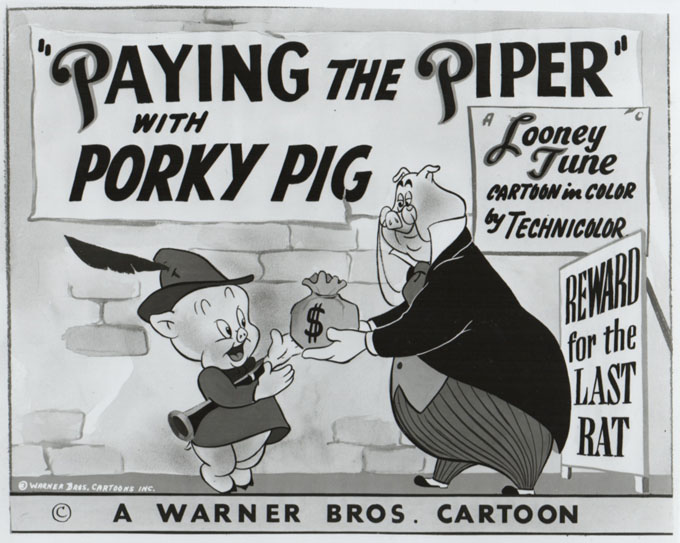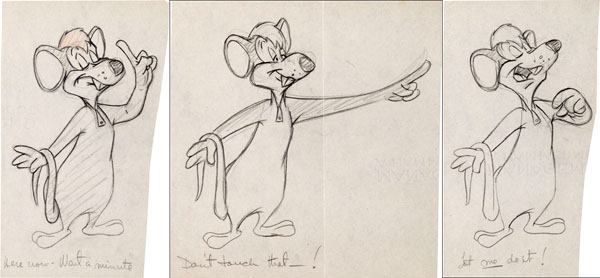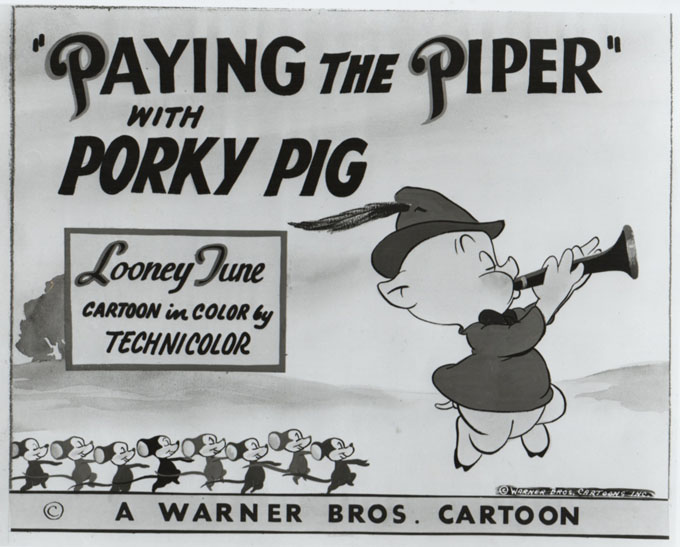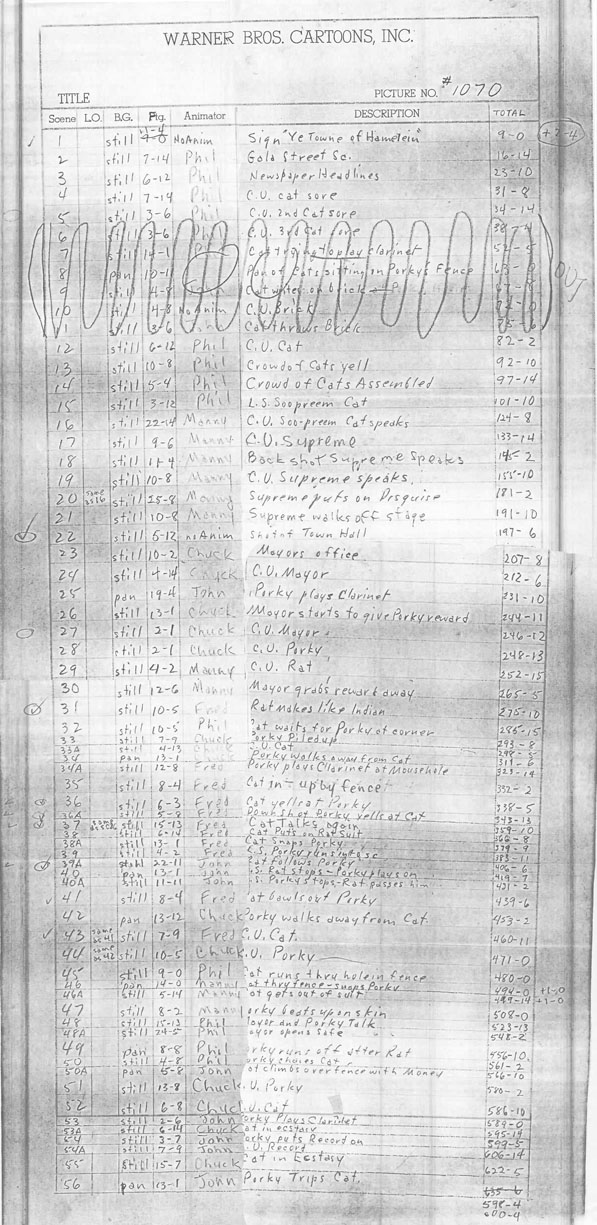
“Ahh, your sister smokes corn silk!” Here’s a fairy-tale spoof from Bob McKimson, featuring Porky Pig!
Paying the Piper can be considered a revised version of the earlier Bob Clampett film Pied Piper Porky (1939), in which Porky “blew some corn right through this horn” to lure an infestation of rats away from the city of Hamelin. Both cartoons have a story credited to Warren Foster; animator John Carey worked on both films, as well. In McKimson’s version of the Pied Piper story, the local cats are outraged by their depleted sustenance and consult the authoritarian “Supreem Cat” to reclaim the rats. Porky is more involved in Paying the Piper – in Pied Piper Porky, much like most of Clampett’s Porky cartoons from that period, he disappears from the middle of the film. McKimson recycled the design of the “Supreem Cat,” donned with a collar and bow tie, in Swallow the Leader, released eight months after this film.

In this film, McKimson gives his animators extended sequences, rather than assigning different shots within a scene, as some of the other McKimson drafts revealed. Phil De Lara animates the opening sequences of the cats reacting to the news of the rats’ evacuation, and their notion to discuss their problem to the Supreem Cat. Manny Gould’s animation introduces the ‘Supreem Cat’, as he elaborates his solution to his adoring devotees, who cease their applause as he signals with his hands. In a nice touch by Gould, the Supreem Cat is struck by an off-screen jeer from an Airedale, as if one of his supporters is a skeptic. De Lara relies more on “smear” drawings as the characters loosely flail their arms and hands, while Gould uses dry-brush effects for hand gestures in his work on the film.
The un-credited Fred Abranz animates the Supreem Cat distracting and scolding Porky for bothering his “sick baby,” and putting on the rat costume, using his tail as a bullwhip to strike Porky from behind. John Carey animates the rat pretending to be lured by Porky’s swinging rendition of Joseph Winner’s “Little Brown Jug” around a street corner, only to run past him from the other side of the frame. Gould animates Porky stuck between fence posts, being lashed by the rat’s tail again, and the following scenes when he pummels the rat costume with his clarinet. De Lara handles the next sequence, when the Supreem Cat steals Porky’s reward money, greeting the Mayor with the catchphrase from Bert Gordon’s radio character “The Mad Russian”—“How do you do-o-o-o?”

Two dialogue recordings with Mel Blanc occurred for this film—the first on November 16 and one week later, on November 23, 1946. It could be possible that Blanc spoke Porky’s lines in one session, and for the other characters—the Supreem Cat, the Mayor of Hamelin, and the various cats—in the other dialogue track recording, given their different vocal ranges. The orchestral score was recorded a year later, on December 6, 1947, the same day as Jones’ Mississippi Hare. Like Pied Piper Porky, the composition used underneath the main titles for Paying the Piper is Felix Mendelssohn’s “Violin Concerto in E Minor, Op. 64—Third Movement.”
The draft for Paying the Piper reveals some early deleted sections (scenes 6-11) before the cats decide to negotiate with the Supreem Cat. They might have been fully animated, since their scenes are assigned to Phil De Lara and John Carey. In reading the descriptions, it seems the Hamelin cats attempt different ways to retrieve the rats back, including a failed attempt to lure them by playing music the clarinet—presumably, badly performed. In the sequence following after, the cats each sit on Porky’s fence, and one of them writes a threatening note, tied to a brick, before throwing it.

Obviously, this was another failed attempt, since scene 12—a sequence in the finished film—is the close-up of one of the cats suggesting they speak with their leader. It’s unclear why McKimson omitted these sequences, but it might have changed for the pacing, though it’s interesting to see a different story aspect to the cats’ wrath. Paying the Piper was released on March 12, 1949 — about fifteen months after the musical score was recorded!

(Thanks to Michael Barrier and Keith Scott for their help.)


 DEVON BAXTER is a film restoration artist, video editor, and animation researcher/writer currently residing in Pennsylvania. He also hosts a
DEVON BAXTER is a film restoration artist, video editor, and animation researcher/writer currently residing in Pennsylvania. He also hosts a 





















































































Aside from the missing scenes, the ending to the cartoon also is a bit on the odd side, where we suddenly change from Porky vs. the disguised Supreme Cat to the cat trying to run away with the town’s money (the change is obviously a set-up for Porky’s end gag with the record and saying he’s going to bring all the rats, but we never get that as being the cat’s idea. He just opts to steal the cash, so the final minute of the cartoon feels like a change of direction and doesn’t flow the way it should. Foster obviously liked the concept, but in both the Clampett version and here, the payoff doesn’t match the story line’s set-up).
That is a weak ending. I suppose had we not seen the phonograph until the last shot, it might’ve came off a little better as the final punch.
Pretty amazing how Porky, after being the butt of Supreem’s taunts (“Your sister smokes cornsilk!”), turns the tables at the end (“Your brother drives a pickle wagon!”) in this regard.
McKimson seemed to like that recycled black cat design since it appears in many other cartoons modified (It’s Hummer Time, Early to Bet, Leghorn Swoggled and the two shorts starring Dodsworth).
“I wonder how he knows so much about my family” – That line cracked me up!
Thank you…a GREAT post!! But my true question !: why (oh why) have i only seen this film twice in my life? It was never aired in the syndicated package, nor network. Why was it always kept so…”obscure!?”
PAYING THE PIPER was in the “Porky Pig and Friends” package of cartoons that Warner syndicated in the 1970s and ’80s.
It did air quite a bit on the Nickelodeon block in the 1990s. That was one of my favorite LooneyTunes blocks because it aired a lot of the rare black-and-whites.
“Paying the Piper” was included in the post-’47 syndicated package through 1990 – WGN-9 in Chicago had this short.
Speaking of soundtracks, the “Act 2: Erschallet, Feierklänge!” movement from Rienzi Overture by Richard Wagner plays towards the beginning. It was featured in a few other Looney Tunes cartoons: Duck Amuck, A Peck O’ Trouble, and Bewitched Bunny.